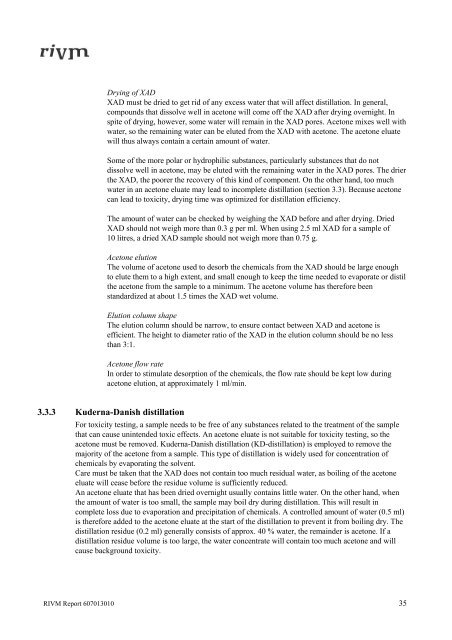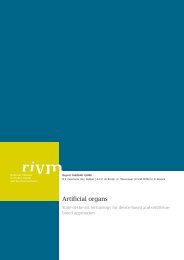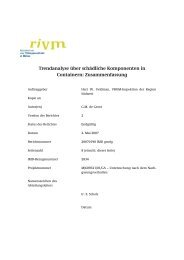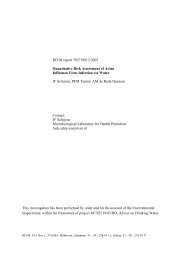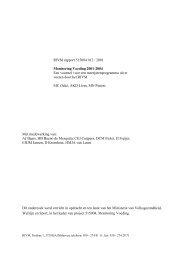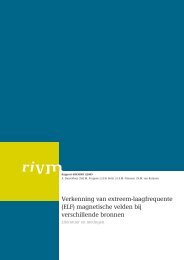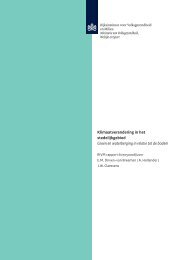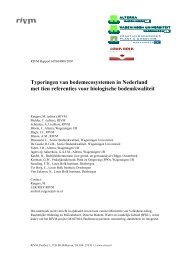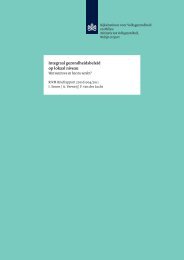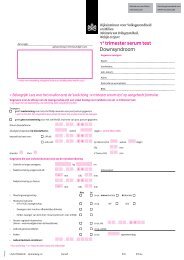Toxicity measurements in concentrated water samples - Rivm
Toxicity measurements in concentrated water samples - Rivm
Toxicity measurements in concentrated water samples - Rivm
Create successful ePaper yourself
Turn your PDF publications into a flip-book with our unique Google optimized e-Paper software.
Dry<strong>in</strong>g of XAD<br />
XAD must be dried to get rid of any excess <strong>water</strong> that will affect distillation. In general,<br />
compounds that dissolve well <strong>in</strong> acetone will come off the XAD after dry<strong>in</strong>g overnight. In<br />
spite of dry<strong>in</strong>g, however, some <strong>water</strong> will rema<strong>in</strong> <strong>in</strong> the XAD pores. Acetone mixes well with<br />
<strong>water</strong>, so the rema<strong>in</strong><strong>in</strong>g <strong>water</strong> can be eluted from the XAD with acetone. The acetone eluate<br />
will thus always conta<strong>in</strong> a certa<strong>in</strong> amount of <strong>water</strong>.<br />
Some of the more polar or hydrophilic substances, particularly substances that do not<br />
dissolve well <strong>in</strong> acetone, may be eluted with the rema<strong>in</strong><strong>in</strong>g <strong>water</strong> <strong>in</strong> the XAD pores. The drier<br />
the XAD, the poorer the recovery of this k<strong>in</strong>d of component. On the other hand, too much<br />
<strong>water</strong> <strong>in</strong> an acetone eluate may lead to <strong>in</strong>complete distillation (section 3.3). Because acetone<br />
can lead to toxicity, dry<strong>in</strong>g time was optimized for distillation efficiency.<br />
The amount of <strong>water</strong> can be checked by weigh<strong>in</strong>g the XAD before and after dry<strong>in</strong>g. Dried<br />
XAD should not weigh more than 0.3 g per ml. When us<strong>in</strong>g 2.5 ml XAD for a sample of<br />
10 litres, a dried XAD sample should not weigh more than 0.75 g.<br />
Acetone elution<br />
The volume of acetone used to desorb the chemicals from the XAD should be large enough<br />
to elute them to a high extent, and small enough to keep the time needed to evaporate or distil<br />
the acetone from the sample to a m<strong>in</strong>imum. The acetone volume has therefore been<br />
standardized at about 1.5 times the XAD wet volume.<br />
Elution column shape<br />
The elution column should be narrow, to ensure contact between XAD and acetone is<br />
efficient. The height to diameter ratio of the XAD <strong>in</strong> the elution column should be no less<br />
than 3:1.<br />
Acetone flow rate<br />
In order to stimulate desorption of the chemicals, the flow rate should be kept low dur<strong>in</strong>g<br />
acetone elution, at approximately 1 ml/m<strong>in</strong>.<br />
3.3.3 Kuderna-Danish distillation<br />
For toxicity test<strong>in</strong>g, a sample needs to be free of any substances related to the treatment of the sample<br />
that can cause un<strong>in</strong>tended toxic effects. An acetone eluate is not suitable for toxicity test<strong>in</strong>g, so the<br />
acetone must be removed. Kuderna-Danish distillation (KD-distillation) is employed to remove the<br />
majority of the acetone from a sample. This type of distillation is widely used for concentration of<br />
chemicals by evaporat<strong>in</strong>g the solvent.<br />
Care must be taken that the XAD does not conta<strong>in</strong> too much residual <strong>water</strong>, as boil<strong>in</strong>g of the acetone<br />
eluate will cease before the residue volume is sufficiently reduced.<br />
An acetone eluate that has been dried overnight usually conta<strong>in</strong>s little <strong>water</strong>. On the other hand, when<br />
the amount of <strong>water</strong> is too small, the sample may boil dry dur<strong>in</strong>g distillation. This will result <strong>in</strong><br />
complete loss due to evaporation and precipitation of chemicals. A controlled amount of <strong>water</strong> (0.5 ml)<br />
is therefore added to the acetone eluate at the start of the distillation to prevent it from boil<strong>in</strong>g dry. The<br />
distillation residue (0.2 ml) generally consists of approx. 40 % <strong>water</strong>, the rema<strong>in</strong>der is acetone. If a<br />
distillation residue volume is too large, the <strong>water</strong> concentrate will conta<strong>in</strong> too much acetone and will<br />
cause background toxicity.<br />
RIVM Report 607013010 35


